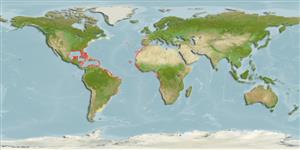Classification / Names
Common names from other countries
Main reference
Size / Weight / Age
Max length : 250 cm TL male/unsexed; (Ref. 2683); common length : 130 cm TL male/unsexed; (Ref. 2683); max. published weight: 161.0 kg (Ref. 26340); max. reported age: 55 years (Ref. 9975)
Length at first maturity
Lm 160.0, range 130 - 128.5 cm
Environment
Marine; freshwater; brackish; reef-associated; amphidromous (Ref. 51243); depth range 0 - 30 m (Ref. 3789), usually 0 - 15 m (Ref. 42064)
Climate / Range
Subtropical, preferred 26°C (Ref. 107945); 49°N - 44°S, 99°W - 14°E (Ref. 55254)
Distribution
Atlantic Ocean: from Nova Scotia, Bermuda and southward to Brazil in western Atlantic Ocean (Ref. 3234, 4446), where it it also found throughout the Gulf of Mexico and the Caribbean (Ref. 26938); from Mauritania to Angola in eastern Atlantic Ocean (Ref. 2845, 3234, 4446, 81266); with exceptional records in Portugal, Azores and Atlantic coast of southern France (Ref. 3234, 4446). It had crossed the Panama canal and was also caught at Coiba Island in the Pacific Ocean (Ref. 4446).
Countries | FAO areas | Ecosystems | Occurrences | Introductions
Short description
Dorsal
spines
(total): 0;
Dorsal
soft rays
(total): 13-16;
Anal
spines: 0;
Anal
soft rays: 22 - 25;
Vertebrae: 53 - 57. Diagnosis: It is characterized by the anterior position of pelvic fin insertions in relation to dorsal-fin origin, and by some morphometric counts: 13-16 dorsal-fin rays, 40-48 lateral-line scales and 53-57 vertebrae (Ref. 2845, 81266).
IUCN Red List Status (Ref. 115185)
Threat to humans
Reports of ciguatera poisoning (Ref. 31172)
Human uses
Fisheries: commercial; aquaculture: commercial; gamefish: yes; aquarium: public aquariums
Tools
Special reports
Download XML
Internet sources
Estimates of some properties based on models
Phylogenetic diversity index
PD50 = 1.0020 many relatives (e.g. carps) 0.5 - 2.0 few relatives (e.g. lungfishes)
Trophic Level
4.5 ±0.0 se; Based on diet studies.
Resilience
Low, minimum population doubling time 4.5 - 14 years (K=0.07-0.10; tmax=55; Fec>1 million)
Vulnerability
Very high vulnerability (76 of 100)
Price category
